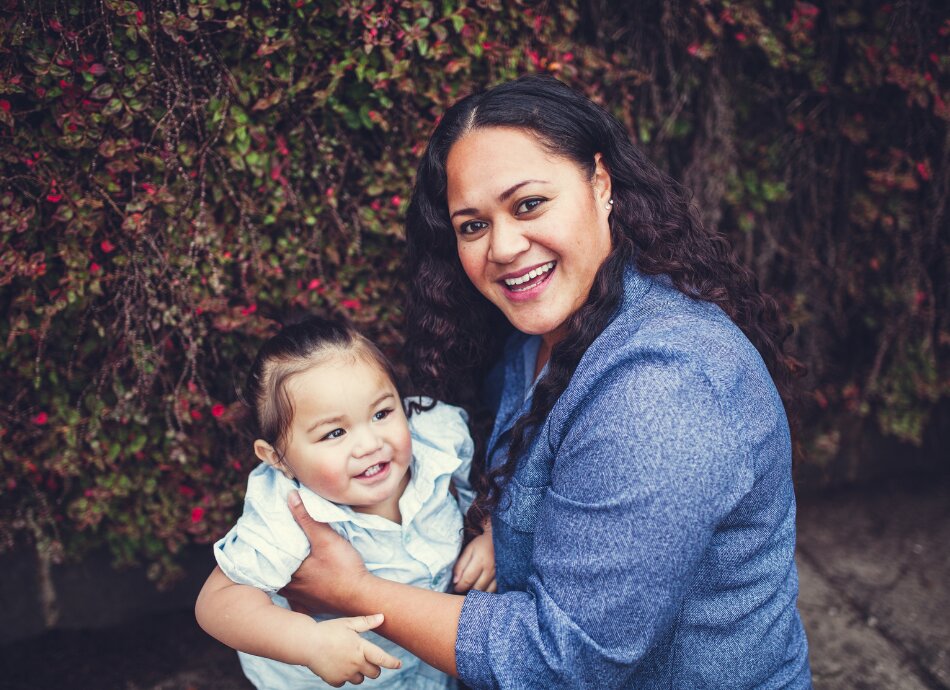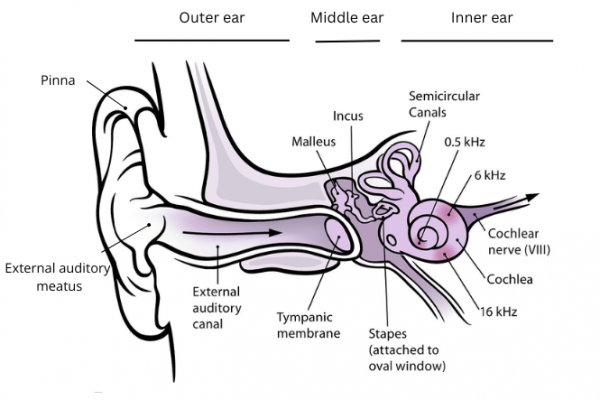Glue ear
Also known as otitis media with effusion (OME) or secretory otitis media (SOM)
Key points about glue ear
- 'Glue ear’ is caused by thick fluid behind the eardrum (middle ear).
- It can affect 1 or both ears and can cause difficulty hearing.
- Glue ear may affect how your child learns to talk.
- Spoken words may not sound as clear to tamariki with glue ear.
- Always see your healthcare provider if you're worried about your child's hearing.
- The content on this page comes from KidsHealth.(external link)

Glue ear happens when your child's middle ear (the space behind the eardrum) is filled with fluid. The fluid can be very thick and sticky, which is why it's called 'glue' ear. It can affect 1 or both ears. Hearing is normally worse if both ears are affected.
Glue ear can start from fluid not clearing after an ear infection. Some tamariki get glue ear without having been unwell and may not have complained of sore ears. The risk factors for glue ear are the same as for ear infections. Read our page on ear infections to find out how fluid can build up in the middle ear.
The image below has the parts of the ear labelled and shows the location of the middle ear.

Image credit: Chittka L, Brockmann(external link) Wikimedia Commons with added labels
During an ear infection, infected fluid fills the space behind the eardrum. It's common for this fluid to take a few weeks to clear away, even if your child has had antibiotics. The fluid gradually clears down the small tube (the eustachian tube) that connects the space behind the eardrum to the back of the nose.
After an ear infection, the fluid clears away completely within 3 months for 80% of tamariki. If the fluid doesn’t clear from the middle ear space after 3 months, this is often called glue ear.
The medical name for glue ear is otitis media with effusion or OME. Glue ear can happen when eustachian tubes become blocked and don't work well. This can be caused by frequent colds, enlarged adenoids (at the back of the nose), or allergies that cause the nose to be blocked.
The video below shows how glue ear develops and affects hearing.
Video: How glue ear develops
(BUPA, UK, 2013)
For tamariki to hear normally, their middle ear needs to be full of air. When there's fluid instead of air, it's harder for the eardrum to vibrate and carry the noise vibrations to the inner ear. This makes it harder for tamariki to hear. If 1 ear is affected, they can sometimes manage OK, but if both ears are affected, your child's hearing can be significantly reduced.
Young tamariki who have hearing loss for long periods can have problems with learning to talk and learning how to pronounce words clearly. With older tamariki, it can also affect their learning at school.
Read more about hearing loss in babies and children.
Tamariki with glue ear aren't usually unwell. They don’t usually complain of any ear pain. Their only symptom may be hearing loss. This may not be something that's easily noticed, and not something they complain about. It's sometimes picked up on a screening preschool hearing test or by a healthcare provider when they're doing a general check of your child’s ears.
It's always a good idea to ask your healthcare provider to check your child's ears at every opportunity. Always tell them if you have any concerns about your child’s hearing or language development.
Hearing loss
The amount of hearing loss in tamariki with glue ear varies. For your child, it can be like trying to hear with earplugs in place – sounds are muffled.
Young tamariki can't tell you about their hearing loss. If your child isn't hearing well, they may:
- ask you to repeat things or say “huh?” or “what?” often
- seem to ignore you or not answer when you speak to them
- not hear things properly
- want the TV or music volume turned up louder
- have a delay in learning how to talk or picking up new words
- have difficulty learning how to pronounce words clearly.
Some tamariki manage very well, despite not hearing normally. In these tamariki, there may be no noticeable problems and they don't complain because their hearing seems normal to them.
Behaviour problems
Reduced hearing may cause behavioural problems, such as a lack of concentration or attention. Tamariki may feel irritable if they keep missing out on what others are saying. If the glue ear is affecting speech development, this can cause frustrations about not being understood.
Sleep problems
Although the fluid in the middle ear doesn't usually cause pain, parents may sometimes say their child doesn't sleep well.
Your healthcare provider will talk with you about what's happening with your child.
Looking in your child's ears
They'll look into your child's ears with an otoscope. An otoscope is a small, powerful light with a magnifying lens.
Many tamariki don't like having their ears examined. To make it easier, you may be encouraged to comfort your child by:
- holding your child sitting sideways on your lap
- wrapping one of your arms gently over their arm
- gently holding their head against your chest with your other hand.
It can sometimes be helpful to talk to your child before you go to the appointment. You can tell them that a special torch will be used to shine a light into their ears.
Video: Ear exam with an otoscope
This video shows a health professional looking inside a young boy's ear canal with an otoscope. 
Tympanometry
Sometimes it can be helpful to assess how well the eardrums are moving. This is done with a special instrument called a tympanometer. This looks very similar to an otoscope and is held to the outer part of the ear in a similar way. If there is fluid in the middle ear, it can measure that the eardrum is not moving well.
Tympanometry is not a hearing test, but it helps give information about the space behind the eardrum, which can sometimes be difficult to see.
Hearing test
Sometimes, your healthcare provider may recommend a hearing test for your child. Hearing tests are done differently for tamariki of different ages.
In many tamariki, the fluid or ‘glue’ in the middle ear can clear away without needing any treatment. Sometimes this can take a few months. For this reason, your healthcare provider may simply recommend regular check-ups for up to 3 months so they can examine your child's ears. If your child has fluid in the middle ear for more than 3 months, there are some treatment options.
Regular checkups
If your child's hearing and development are normal, your healthcare provider may recommend this option. As your child gets older, the fluid is more likely to clear away with time. This is because their eustachian tubes mature and generally work better as they get older.
It's important to take your child to a healthcare provider for regular check-ups during this time.
Grommets
Some tamariki with glue ear may benefit from grommets. These are very small plastic tubes that are placed in the eardrum. Grommets help keep air in the space behind the eardrum, which improves hearing.
Grommets require a short general anaesthetic to put in. They're designed to be temporary, usually staying in place for about a year. If your child does need grommets, your healthcare provider may recommend an appointment with an ENT (ear, nose and throat) specialist to assess your child and discuss this option further. Read more about grommets.
Other treatments for glue ear
Longer courses of antibiotics have been used in the past as treatment for glue ear. But, there are concerns about the side effects from having long courses of antibiotics, including the development of antibiotic resistance, allergic reactions, diarrhoea (runny poo) and thrush. There's no good evidence that long courses of antibiotics work for glue ear. This is because active infection isn't present in glue ear, so multiple or longer courses of antibiotics aren't recommended when there are no signs of infection.
The following treatments also don't work and shouldn't be used as treatment for glue ear:
- decongestants (such as Pseudoephedrine, Otrivin)
- steroids (such as Prednisone).
If your child has glue ear, they may not be able to hear you. It can be helpful to get their attention before you speak to them. Remember to speak slowly and clearly to your child. Try to make sure your child can see your face when you're speaking to them and try to reduce background noise.
Let your child's teachers know that they have glue ear and ask if they can sit towards the front of the class. Teachers will be aware of the importance of making sure tamariki hear as well as possible. They'll understand that they'll need to get their attention if they're speaking with your child when they have glue ear.
Don't smoke or allow your friends and whānau to smoke around your tamariki.
Apps reviewed by Healthify
You may find it useful to look at some hearing test apps.
If you're concerned about your child's hearing or language development, see your healthcare provider.
Some areas have mobile children's ear clinics which visit schools and early childhood education centres. If your area has a mobile clinic, you could also talk to one of the ear nurse specialists. They're specially trained to diagnose, treat, monitor and refer tamariki with middle ear problems.
If your child has glue ear for more than 3 months or repeated episodes of persistent middle ear fluid, they should be referred to an ENT (ear, nose and throat) specialist. Your healthcare provider can do a referral. Your healthcare provider or ENT (ear, nose and throat) specialist may arrange a hearing test for your child.
If your child has had grommets inserted and you're still concerned about their hearing or they have other developmental issues, they may need a hearing test and further assessments. Make sure you discuss your concerns with your healthcare provider.
Grommets (tympanostomy or ventilation tubes)(external link) KidsHealth, NZ
Your child's speech and hearing milestones(external link) National Foundation for the Deaf, NZ
Ear infections, earache and glue ear(external link) HealthEd, NZ, 2021
Universal Newborn Hearing Screening Programme(external link) National Screening Unit, NZ
Apps
Otitis media – a common childhood illness(external link) Best Practice Journal, NZ, 2022
The tympanic membrane – diagnostic picture tests(external link) BMJ Learning, UK, 2023
Otitis media with effusion in under 12s – NICE guideline(external link) NICE, UK, 2023
Credits: Content shared between KidsHealth and Healthify He Puna Waiora as part of a National Health Content Hub Collaborative.
Last reviewed:





